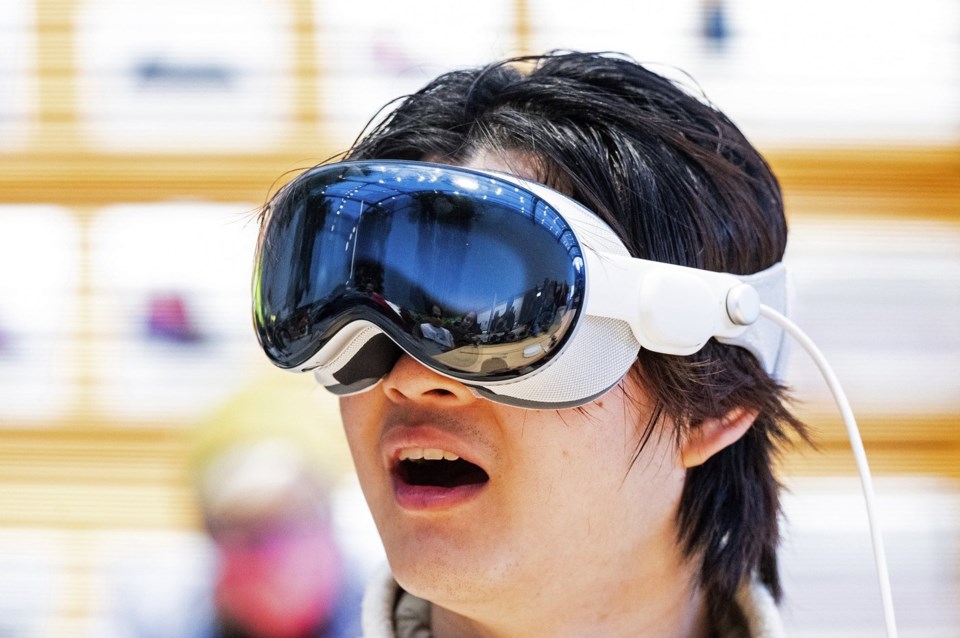Canadians can now get their hands on Apple's flashiest piece of technology, but some warn they shouldn’t expect the device to become ubiquitous just yet.
The Vision Pro, Apple's augmented reality headset, made its debut Friday at all of the tech giant's stores in Canada, France, Germany and the U.K.
The headset, which carries a starting price of $5,000 in Canada, welcomes wearers into a digital world fit for immersive experiences, browsing photos, participating in meetings, watching movies, playing games and more.
Its Canadian debut is of particular interest because the device has garnered plenty of buzz in the year since it was unveiled but has yet to proliferate in the same way other Apple gadgets have. Thus, a new market means a new opportunity to boost sales.
When the device was first revealed in June last year, Apple was projected to sell between half a million and one million Vision Pros, said Wamsi Mohan, a senior information technology hardware analyst with Bank of America. He thinks the figure is probably closer to half a million today.
Sales on the low end of forecasts are likely the product of the Vision Pro's price, he said. The cheapest model costs $4,999 for 256 GB of storage but one terabyte of storage will set you back $5,599.
"You could buy maybe three MacBook Airs for the price of one Vision Pro," Mohan said. "It makes people pause and I think that's what we're seeing in the market."
The challenge Apple faces is making people see past the price tag and buy into the device's potential. Mohan, who owns a Vision Pro and uses it fairly frequently, said that's a hurdle "that is not very easy to overcome" because humans are "just not used to anything like" the device.
"It takes time to get people adapted to very different types of computing paradigms," he said.
So far, Apple has been working to tackle the issue by offering demonstrations at its stores, where staff show off the device’s capabilities to consumers without requiring them to make a purchase.
"Seeing is believing," said Mike Rockwell, the vice-president of Apple's vision products group.
"(The Vision Pro) is one of those things that describing it in words or even in video pales by comparison to the actual product experience."
A demo Apple hosted for The Canadian Press showed how apps available for the headset can put wearers face-to-face with a dinosaur that responds to them based on their actions. For example, petting the creature will make it treat you kindlier.
Another app allowed wearers to place a Formula One car once used by Alfa Romeo in the room you're in, make it as big as the real vehicle or as small as a toy and then take parts like the tires off to more closely examine them.
Users navigate the experience by looking in different directions and gesturing with their hands. Changes to the opacity make wearers aware of their surroundings while their headset is on and also allow people around them to see their eyes at times.
"There's never been a product like this," Rockwell said.
"It allows you to have media experiences that are unprecedented for a consumer and that you can take with you. It gives you this ultimate productivity environment that brings together actually all of Apple's ecosystem and it's an incredibly powerful platform."
And what the device can do these days is just the start. Technologists imagine a day where the Vision Pro or devices like it could be used as often as cellular phones, becoming a staple in every office and home.
Before it hits that point, Mohan thinks Apple has some work to do to make it even more user-friendly.
The device, he said, could be lighter – the lightest models weigh about 600 grams, roughly the weight of a basketball – or made more affordable through a review process the company typically carries out before launching its next generation models.
"The gen one of the watch, for instance, could not hold charge for the full day and that was kind of deemed to be a failure. Gen one of the AirPods were considered sort of silly to walk around without the wires," he said.
"So I think there is a lot of learning that happens between gen one and gen two for Apple to understand like what is the consumer specifically looking for."
Asked about what the next few years look like for the Vision Pro, Rockwell stuck to Apple’s secretive modus operandi.
"We don't really talk about future stuff,” he said. "But what I can say is we're very excited about where it is as a platform today.”
This report by The Canadian Press was first published July 12, 2024.
Tara Deschamps, The Canadian Press
